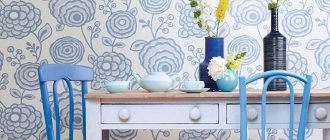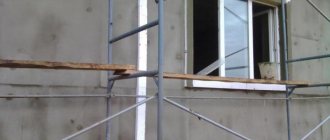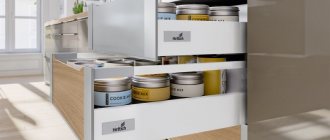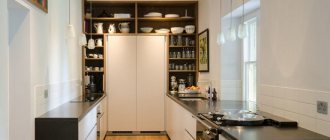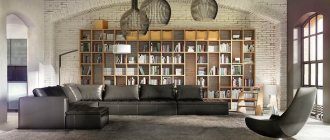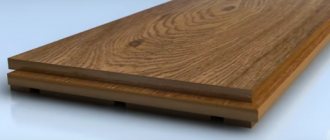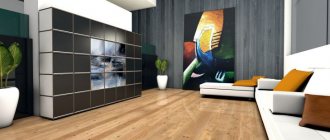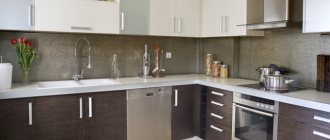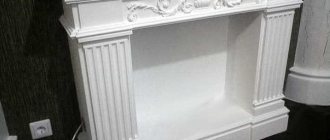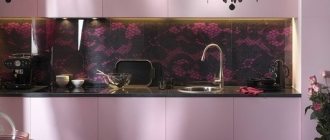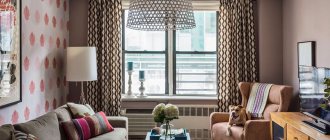When creating a kitchen interior, it is important to think through every detail. The owners of the house spend quite a lot of time in this room, so they want the overall design of the room to be holistic and harmonious. In this case, being in the kitchen will be pleasant and cozy. Furniture facades are one of the important elements of the interior, so their choice should be taken responsibly.
Which facade is better to choose for the kitchen? Advice from experienced designers will help you understand this issue. This decorative element must fit harmoniously into the overall style of the interior, as well as be practical and resistant to various adverse factors. The question of how to choose the material and design for the facades of kitchen furniture will be discussed in detail in the article.
Requirements for facades
When studying the question of which facade is better and the right one to choose for the kitchen, you should consider the basic requirements for this element of the interior. The frame of cabinets helps create a strong, reliable foundation for furniture. The facade is responsible for aesthetic perception, so first of all it must be beautiful and impressive.
After this, owners must also consider the operational characteristics of the facades. Such products must be resistant to adverse influences, in particular, high humidity and temperature changes. Their surface should not be subject to mechanical stress. It is also important that the facade coating can be easily maintained.
Ready-made kitchens are available for sale. They are purchased when making major renovations to the premises. If there is no need or opportunity to completely update the furniture yet, you should think about purchasing and installing only new facades.
Basic requirements for kitchen facades
Kitchen facades are responsible for the appearance of the kitchen and its aesthetic component.
But this does not mean at all that when choosing these elements of a headset you can be guided only by your taste. It is equally important to dress your kitchen in a durable and durable outfit. Here are a few quality standards that will help you make the only right decision: – moisture resistance;
– resistance to high temperatures;
– hygiene, i.e. resistance to mold and mildew;
– resistance to mechanical stress (scratches, abrasions, impacts);
– resistance to fats and food coloring pigments;
– ease of installation and maintenance;
– environmental friendliness;
– durability;
– aesthetics.
It is worth recognizing that not a single material or coating for kitchen facades meets absolutely all of the above requirements. But there are such samples that have absorbed the maximum of advantages, and the disadvantages that are inherent in them are so insignificant that they can easily be leveled out with the help of modern means of protection.
What to look for when choosing?
Advice from experienced designers will help you understand which façade is best to choose for your kitchen. The material from which such decorative elements will be made must be durable and beautiful. However, it should be understood that the facades must be harmoniously integrated into the overall style of the interior so that they complement it.
For example, bright plastic material will look ridiculous in a classic kitchen design. In the high-tech style, wooden facades with carvings will also be inappropriate. Therefore, before purchasing, you should think about the overall image of the room.
The kitchen set must be in harmony with the walls, floor, splashback and other interior elements. This applies to both its color and texture. You should not buy beige furniture for a room with a gray floor and red wallpaper with a green pattern. All the nuances should be thought through, and if necessary, you can seek advice from a professional designer.
Types of kitchen facades
Modern furniture manufacturers offer the following types of kitchen facades:
Frame fronts for kitchen cabinets
Frame facades are structures in the form of a combination of two materials, one of which makes up the middle of the canvas, and the other is its frame.
Sometimes the same material is used, and the frame structure of the product is determined by design features. But most often, facades are made from different materials, and more expensive options are used for the frame.
Framing can be:
Frame facades have the following advantages:
- affordable cost;
- possibility of manufacturing products of non-standard sizes;
- the combination of two materials within one design gives a wide scope for design imagination and allows you to bring to life the most daring interior solutions.
Such designs also have disadvantages:
- presence of seams;
- difficulty washing;
- reduced wear resistance.
Solid kitchen fronts
The solid facade of the kitchen cabinet is more practical and is a slab without seams or joints. It is characterized by increased strength, is not afraid of moisture and does not deform at high temperatures.
The only disadvantage of solid facades is the high cost.
Material
Before purchasing furniture, owners must decide which facade material is best to choose for the kitchen. There are a large number of options on sale today. The choice depends on the overall style of the interior, as well as the financial capabilities of buyers.
The most expensive material for facades is natural wood. Acrylic follows next. This material is of artificial origin, but its advantage is the absence of harmful impurities in its composition.
A façade made of painted MDF will cost slightly less. This is followed by plastic and chipboard. Almost at the same cost level as them are facades made of MDF in PVC film. The cheapest material is chipboard with a special coating. To choose the best option, you need to consider the advantages and disadvantages of each of them.
What material to choose for the kitchen facade
The beauty, durability and cost will directly depend on which façade you choose for your kitchen. However, the belief that the higher the price, the longer the furniture will last is not always true, since facades made of natural solid wood, although they have excellent characteristics, can quickly lose their attractiveness due to humidity and the lack of a high-quality protective layer.
- The most practical are MDF facades made from compressed chips, which give the material excellent performance characteristics: strength, good quality, retention of shape and color over many years.
- Chipboard facades do not differ in appearance from MDF, but are significantly inferior to them in all respects. They quickly collapse, especially in the place where the fittings are attached, which is why the doors sag and quickly lose their shape, and drilling hinges in loose fibers will become a big problem in a few years.
- If you are not limited in finances, but have not decided how to choose a facade for the kitchen, turn your attention to wood and metal. These facades are the most practical and expensive; they are characterized by high moisture resistance, resistance to household chemicals and high temperatures, and wear resistance. Cons: difficult to maintain, since all drops, scratches and fingerprints are visible on the mirror metal surface, which will have to be wiped off often.
Solid wood facades
Natural wood is one of the best materials for arranging kitchen facades. This raw material has many advantages. A kitchen set made from it will look luxurious and impressive.
When thinking about which kitchen façade is best to choose, this option should be considered first. A set made of natural wood will harmoniously fit into a classic or country style interior.
In recent years, provincial and Scandinavian motifs in interior design have been gaining popularity. Their distinctive features are the presence of natural shades, some roughness of finishing and simplicity. In this design, a facade made of natural wood will be more than appropriate.
The finishing of this material is quite complex and requires precise adherence to technology. This naturally affects the cost of finishing. It varies from 5 to 10 thousand rubles/m².
Types of kitchen facades
The facade is the front part of the furniture - the front part of drawers, cabinet doors, etc. Depending on the type of construction, they can be divided into: frame and solid. Frame panels, respectively, consist of a frame and a panel (thin board or plywood); they often combine several materials. Solid facades are always made from only one material.
Facades made of wood and plastic
Advantages and disadvantages of wood
The advantages and disadvantages of the material must be taken into account when purchasing furniture, as this allows you to accurately determine which façade is best to choose for the kitchen. The advantages of solid wood are its strength and durability. This material is practically not subject to mechanical stress. It has a luxurious appearance, decorating the interior of the room.
Natural wood can also be restored. Over time, when scratches and abrasions appear on the surface, the top layer can be removed using special equipment. This will return the facades to their original appearance.
The disadvantage of the presented material is its high cost. Also, if processed incorrectly, such facades can become deformed. Over time, under the influence of sunlight, wood becomes dull. However, all the shortcomings are compensated by the advantages of the presented material.
Choosing the base of the kitchen facade
The most common material that meets all the stated requirements for reliable and long-term use of furniture is currently MDF. Wood waste boards are a material made from fine wood dust compressed under high pressure. MDF is considered an environmentally friendly material because the substance used to glue the particles together is part of the wood waste itself and is exposed to high pressure.
MDF boards are strong and durable, resistant to moisture and high temperatures. One of the distinctive advantages compared to solid wood, for example, is the ability to produce bent shapes. Rounded and wavy facades are in demand among a large number of our compatriots.
Another popular material that stands on the other side of the price line is chipboard. These are slabs made of wood chip material, glued together using special resins of synthetic origin. In this regard, there is no need to talk about the environmental friendliness of such a material for making furniture as chipboard. In terms of strength and durability, chipboards are significantly inferior to MDF. The same can be said about moisture resistance - if the facade coating is damaged, then when moisture gets on the base, fairly rapid wear, swelling and aging of the material will occur.
For those who are not going to save on making kitchen furniture, we can offer the most environmentally friendly material option - solid wood. Among the obvious advantages of natural material, in addition to safety for humans and the environment, one can highlight a noble appearance, relevance at all times and the sophistication of natural colors. But natural materials have their drawbacks. In addition to the high cost (and some types of wood are very expensive), wood must be carefully looked after - monitor moisture ingress, temperature changes (which is not easy in a room with a stove, oven and hob), use special waxes and pastes to protect surfaces. In addition, facades made of natural wood are sensitive to direct sunlight - a change in surface color is inevitable.
To create a clean and fresh kitchen environment, light wood for kitchen furniture and snow-white wall decoration are perfect.
In addition to solid wood facades, paneled products are used. This material is cheaper because only the frame of the kitchen facade is made from solid wood, and the inside is filled with so-called paneling - MDF or chipboard and finished with veneer. The appearance of paneled facades is no different from solid wood, but the strength characteristics of the material are noticeably improved, the problem of rapid deformation disappears, not to mention the reduction in cost of the finished product.
MDF facades
When considering the options for which material is best to choose for the kitchen facade, you can give preference to MDF-based structures. They have a lot of positive qualities, and the cost will be less than that of natural wood. Prices start from 3 thousand rubles per square meter.
Due to a certain production technology, MDF is a fairly dense material, so it can be easily processed, creating clear and elegant lines. This is an environmentally friendly material. With the gradual destruction of its surface, substances harmful to the human body are not released.
The MDF panel can be covered in various ways. There are painted facades, finished with plastic or coated with PVC film. There are also panels finished with veneer.
Painted MDF facades
Facades made of MDF panels, which are painted in bright, rich colors during processing, are in high demand. The material is primed and then coated with paint in several layers. Glossy surfaces are polished.
The advantages of the presented material include a large selection of shades and textures of facades. There are matte and glossy surfaces. When hot liquid gets on the facade, the coating does not deform. This option should be considered as one of the best when deciding which façade is best to choose for the kitchen. The disadvantages of the material should also be taken into account before purchasing.
Painted MDF panels are quite expensive. Glossy surfaces leave clear fingerprints and even minor dirt is visible. Color fades over time when exposed to direct sunlight. The surface is easily chipped and scratched.
MDF with PVC film
MDF panels can be covered with PVC film. This allows us to reduce the cost of facades. The advantage of this material is also a large selection of shades and surface textures. There are even embossed facades.
Such surfaces are resistant to mechanical stress. They are easy to clean - you can use regular non-abrasive products. In addition, this type of coating goes well with modern dishes and room decoration elements. However, the presented material is not suitable for every type of interior. When considering which facade is best to choose for a kitchen in a classic style, you should not choose MDF with PVC film. In this case, the furniture will look unnatural.
PVC film is destroyed under the influence of high temperatures. Therefore, care must be taken when using facades. It is not possible to restore damaged coating.
How to choose the right kitchen façade color
Whatever style you decide to decorate your kitchen in, the most difficult question will always be “what facade color to choose for the kitchen.” To make the right decision, follow these recommendations:
- A successful choice of shade is impossible without taking into account the size and lighting. Matte facades look good in a large and bright room. Glossy - in compact and dark.
- Red shades will make the space warm and cozy, blue shades will give the kitchen a clean and tidy look.
- If the kitchen is small, always choose white, cream, milk or ivory - this will visually increase the space.
- Monochrome design of facades - black and white, suitable for any kitchen. Experts advise to punctuate such an interior with bright accessories.
- Colors should be combined with caution, for example, yellow and green, yellow with blue and red, green with orange “get along” well with each other.
- A country-style kitchen will suit furniture in beige, coffee and terracotta shades.
Plastic covering
MDF and chipboard panels can be covered with plastic. This option can be considered when deciding which facade for the kitchen is better to choose. Customer reviews allow us to conclude that the quality of such material directly depends on its cost. There are both expensive and cheap plastic facades.
The advantages of the presented material include high resistance to elevated temperatures. Plastic does not lose its color when exposed to sunlight. This material is also moisture resistant. It is easy to maintain and resistant to mechanical stress.
The disadvantages include the rapid loss of the appearance of the edge. Aluminum sides fade, polymer types of edging quickly deteriorate. Contaminants accumulate between the edge edge and the plastic panel. Also, traces of dirt and fingerprints are visible on glossy surfaces.
Chipboard facade
When considering which facade is best to choose for the kitchen, many owners give preference to chipboard panels. Today this is the most popular type of material. The vast majority of kitchen facades are made from it.
This is one of the cheapest materials. At its low cost, it has good performance characteristics. This is an easy-to-maintain material. It is resistant to scratches and chips. However, chipboard also has a number of disadvantages.
This material does not tolerate moisture on its surface, so all seams and joints must be carefully treated with sealant. If water gets on the chipboard, the material swells and deforms. It should also be noted that it is created using formaldehyde components. When the surface of facades is destroyed, this substance can be released into the environment and negatively affect the human body. Prices, by the way, start from 4 - 5 thousand rubles per square meter.
Frame facades
When deciding which facade is best to choose for the kitchen, you should consider one of its new types. Frame panels can be made of aluminum or MDF. This material serves as a profile into which glass, wood or plastic is installed.
Frame facades look good in fusion and high-tech style. Many design solutions can be implemented in this new direction of interior design. Aluminum frames are considered durable and reliable. They are not affected by moisture. When choosing facades of this type, it is possible to create an original, effective design.
MDF frames are less durable than their aluminum variations. Plastic inserts can become deformed when exposed to high temperatures. Therefore, when choosing this type of furniture, it is very important to pay attention to the performance characteristics of the materials.
Having considered what types of facades are on sale today, as well as their main characteristics, everyone will be able to choose the best option for the interior of their kitchen.
Selection of kitchen fronts
Types of facades
The kitchen façade is, without exaggeration, the “face” of the kitchen, precisely the element that determines its style. A wide range of facades of various types available on the modern furniture market allows you to make the most free choice. That is why, when deciding which kitchen fronts are best suited for a particular room, you should analyze all available options.
Slab and frame facades
According to their design, kitchen facades are divided into two large groups:
- Slab facades.
- Frame fronts for the kitchen.
Slab facades include:
- Slab facades made of laminated chipboard panels with an edge made of aluminum profile.
- Slab facades made of MDF panels coated with vinyl film.
- Slab facades made of MDF panels coated with enamel paint.
- Facades made of MDF or chipboard panels covered with plastic (so-called plastic facades).
- Solid wood facades.
- Veneered facades (base – MDV or chipboard, covering – natural wood veneer, mainly expensive species).
Kitchen with MDF fronts
Unlike slab facades, frame facades have a more complex structure: the basis of the design of such a facade is a frame into which the filling is installed.
The most common types of frame facades include:
Paneled façade design
- Facades with a solid wood frame, filling (panel) - solid wood panel, laminated MDF, veneer panels, etc.
- Facades with a frame made of MDF, filling - as in the previous version.
- Facades with a frame made of aluminum profile, filled with glass or mirror.
Note! A separate group of kitchen facades consists of frameless glass facades. For their production, either tempered (heat-strengthened) glass or triplex is used.
Factors influencing the choice of façade
How to choose from such a variety? How to determine which facades are best for the kitchen?
To make the selection process easier for you, we have identified several criteria by which you can select a material for the facade:
- Appearance is one of the most important criteria. Since the facades determine the entire appearance of our kitchen, they must look presentable and also fit into the overall design of the room.
- Resistance to factors such as humidity and temperature. The facade in the kitchen is in rather extreme conditions, and if you choose the wrong material, the beauty of the facade will not last long.
- Easy to care for . Kitchen furniture will have to be washed quite often - deal with it! Therefore, you need to choose a facade that will be washed relatively easily - without extra effort on your part.
Cleaning the kitchen facade
Advice! An important factor in deciding the question, “Which is the best façade for the kitchen?” the façade surface will be resistant to detergents. The more stable the façade, the easier it will be for you to keep it clean, because many kitchen stains require the use of fairly aggressive chemicals.
- Price is another factor that cannot be ignored. For example, everyone would like furniture made from expensive solid wood or tempered tinted glass - but its cost is quite a serious obstacle to purchase.
These questions are a kind of instruction for those who choose the best kitchen facades. What options can we choose from?
